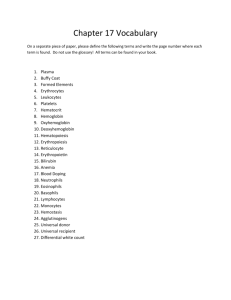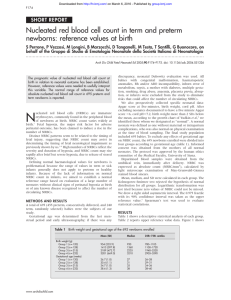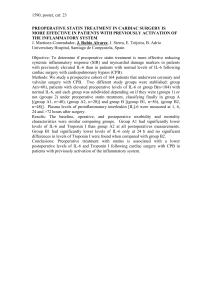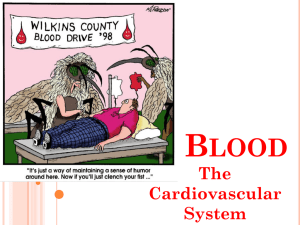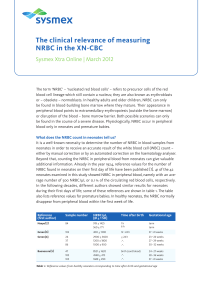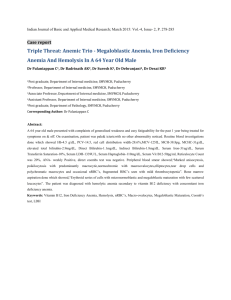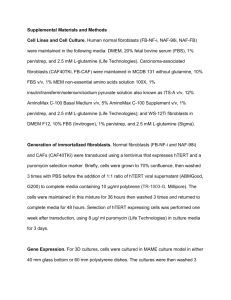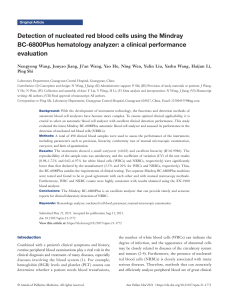association between nucleated red blood cells in blood
advertisement
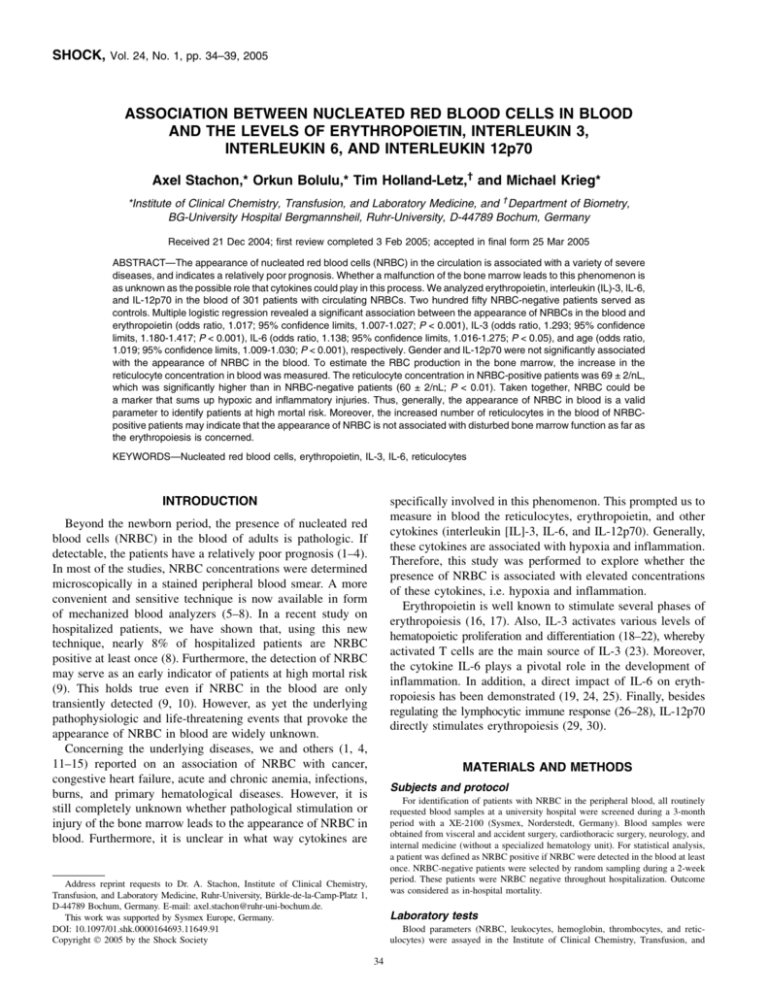
SHOCK, Vol. 24, No. 1, pp. 34–39, 2005 ASSOCIATION BETWEEN NUCLEATED RED BLOOD CELLS IN BLOOD AND THE LEVELS OF ERYTHROPOIETIN, INTERLEUKIN 3, INTERLEUKIN 6, AND INTERLEUKIN 12p70 Axel Stachon,* Orkun Bolulu,* Tim Holland-Letz,† and Michael Krieg* *Institute of Clinical Chemistry, Transfusion, and Laboratory Medicine, and † Department of Biometry, BG-University Hospital Bergmannsheil, Ruhr-University, D-44789 Bochum, Germany Received 21 Dec 2004; first review completed 3 Feb 2005; accepted in final form 25 Mar 2005 ABSTRACT—The appearance of nucleated red blood cells (NRBC) in the circulation is associated with a variety of severe diseases, and indicates a relatively poor prognosis. Whether a malfunction of the bone marrow leads to this phenomenon is as unknown as the possible role that cytokines could play in this process. We analyzed erythropoietin, interleukin (IL)-3, IL-6, and IL-12p70 in the blood of 301 patients with circulating NRBCs. Two hundred fifty NRBC-negative patients served as controls. Multiple logistic regression revealed a significant association between the appearance of NRBCs in the blood and erythropoietin (odds ratio, 1.017; 95% confidence limits, 1.007-1.027; P < 0.001), IL-3 (odds ratio, 1.293; 95% confidence limits, 1.180-1.417; P < 0.001), IL-6 (odds ratio, 1.138; 95% confidence limits, 1.016-1.275; P < 0.05), and age (odds ratio, 1.019; 95% confidence limits, 1.009-1.030; P < 0.001), respectively. Gender and IL-12p70 were not significantly associated with the appearance of NRBC in the blood. To estimate the RBC production in the bone marrow, the increase in the reticulocyte concentration in blood was measured. The reticulocyte concentration in NRBC-positive patients was 69 2/nL, which was significantly higher than in NRBC-negative patients (60 2/nL; P < 0.01). Taken together, NRBC could be a marker that sums up hypoxic and inflammatory injuries. Thus, generally, the appearance of NRBC in blood is a valid parameter to identify patients at high mortal risk. Moreover, the increased number of reticulocytes in the blood of NRBCpositive patients may indicate that the appearance of NRBC is not associated with disturbed bone marrow function as far as the erythropoiesis is concerned. KEYWORDS—Nucleated red blood cells, erythropoietin, IL-3, IL-6, reticulocytes INTRODUCTION specifically involved in this phenomenon. This prompted us to measure in blood the reticulocytes, erythropoietin, and other cytokines (interleukin [IL]-3, IL-6, and IL-12p70). Generally, these cytokines are associated with hypoxia and inflammation. Therefore, this study was performed to explore whether the presence of NRBC is associated with elevated concentrations of these cytokines, i.e. hypoxia and inflammation. Erythropoietin is well known to stimulate several phases of erythropoiesis (16, 17). Also, IL-3 activates various levels of hematopoietic proliferation and differentiation (18–22), whereby activated T cells are the main source of IL-3 (23). Moreover, the cytokine IL-6 plays a pivotal role in the development of inflammation. In addition, a direct impact of IL-6 on erythropoiesis has been demonstrated (19, 24, 25). Finally, besides regulating the lymphocytic immune response (26–28), IL-12p70 directly stimulates erythropoiesis (29, 30). Beyond the newborn period, the presence of nucleated red blood cells (NRBC) in the blood of adults is pathologic. If detectable, the patients have a relatively poor prognosis (1–4). In most of the studies, NRBC concentrations were determined microscopically in a stained peripheral blood smear. A more convenient and sensitive technique is now available in form of mechanized blood analyzers (5–8). In a recent study on hospitalized patients, we have shown that, using this new technique, nearly 8% of hospitalized patients are NRBC positive at least once (8). Furthermore, the detection of NRBC may serve as an early indicator of patients at high mortal risk (9). This holds true even if NRBC in the blood are only transiently detected (9, 10). However, as yet the underlying pathophysiologic and life-threatening events that provoke the appearance of NRBC in blood are widely unknown. Concerning the underlying diseases, we and others (1, 4, 11–15) reported on an association of NRBC with cancer, congestive heart failure, acute and chronic anemia, infections, burns, and primary hematological diseases. However, it is still completely unknown whether pathological stimulation or injury of the bone marrow leads to the appearance of NRBC in blood. Furthermore, it is unclear in what way cytokines are MATERIALS AND METHODS Subjects and protocol For identification of patients with NRBC in the peripheral blood, all routinely requested blood samples at a university hospital were screened during a 3-month period with a XE-2100 (Sysmex, Norderstedt, Germany). Blood samples were obtained from visceral and accident surgery, cardiothoracic surgery, neurology, and internal medicine (without a specialized hematology unit). For statistical analysis, a patient was defined as NRBC positive if NRBC were detected in the blood at least once. NRBC-negative patients were selected by random sampling during a 2-week period. These patients were NRBC negative throughout hospitalization. Outcome was considered as in-hospital mortality. Address reprint requests to Dr. A. Stachon, Institute of Clinical Chemistry, Transfusion, and Laboratory Medicine, Ruhr-University, Bürkle-de-la-Camp-Platz 1, D-44789 Bochum, Germany. E-mail: axel.stachon@ruhr-uni-bochum.de. This work was supported by Sysmex Europe, Germany. DOI: 10.1097/01.shk.0000164693.11649.91 Copyright Ó 2005 by the Shock Society Laboratory tests Blood parameters (NRBC, leukocytes, hemoglobin, thrombocytes, and reticulocytes) were assayed in the Institute of Clinical Chemistry, Transfusion, and 34 SHOCK JULY 2005 CYTOKINES Laboratory Medicine (Berufsgenossenschaftliche Kliniken Bergmannsheil, RuhrUniversity, Bochum, Germany) with the use of a XE-2100 (Sysmex) in accordance with the recommendations of the manufacturer. Stringent internal quality control measurements were performed and the criteria of acceptance were fulfilled throughout. The manufacturers’ NRBC detection limit was greater than 19/mL. Alanine aminotransferase and creatinine were measured with a CHEM 1 analyzer (Bayer Vital, Fernwald, Germany) and C-reactive protein was assayed with an Array 360 (Beckman Coulter, Krefeld, Germany), all in accordance with the recommendations of the manufacturers. The quality assurance of quantitative determinations was strictly performed according to the German Norm: Quality Assurance in Medical Laboratories (DIN 58936 part 1, 1989). The criteria of acceptance were fulfilled throughout. This study was approved by our Institutional Human Use Committee and informed consent was obtained. Measurement of erythropoietin, IL-3, IL-6, and IL-12p70 After analyzing the whole blood sample for various parameters, including NRBC, the samples were centrifuged. The resulting plasma was stored at –80°C until measurement of erythropoietin, IL-3, IL-6, and IL-12p70. The plasma concentrations of the cytokines were determined in that sample of each NRBC-positive patient in which the highest NRBC concentration was found. Measurements were performed by enzyme-linked immunoabsorbant assay (IBL, Hamburg, Germany or R&D Systems, Wiesbaden, Germany) with the following measurement ranges: erythropoietin, 2-64 mU/mL; IL-3, 30-1000 pg/mL; IL-6, 0.6-2000 pg/mL; and IL-12p70, 4-2000 pg/mL. Measured concentrations above the upper range limit were set to the upper limit. Measured concentrations below the lower detection limit were considered as zero. Statistical analysis Data are presented as the mean SEM. Correlation coefficients were calculated by Spearman correlation. Statistical differences between two groups were analyzed with the Mann-Whitney U test and the chi-square test. By multiple logistic regression, the odds ratios for the detection of NRBC in the blood of the following parameters were assessed: age, gender, erythropoietin, IL-3, IL-6, and IL-12p70. Generally, the multiple logistic regression model requires normally distributed samples. Therefore, concentrations of IL-3, IL-6, and IL-12p70 were logarithmically transformed. In general, P < 0.05 was considered statistically significant. RESULTS Patient characteristics A total number of 551 patients (mean age, 59 1 years; 299 men and 252 women) were included in this study, i.e., 301 NRBC-positive patients and 250 NRBC-negative patients, serving as control. Baseline clinical data of NRBC-positive and IN PATIENTS WITH NRBC IN 35 BLOOD NRBC-negative patients are shown in Table 1. In-hospital mortality of NRBC-negative and NRBC-positive patients is shown in Figure 1. The detection of NRBC in the blood was not associated with one particular cause of death (Fig. 2). The mean NRBC concentration in patients who died due to malignant tumors (55 14/mL) was significantly lower than in those patients who died due to cardiac failure (338 101/mL, P < 0.001) or multiorgan failure (399 108/mL, P < 0.05). However, during the detection of NRBC in blood, none of the deceased NRBCpositive patients with malignant tumors were provided with chemotherapy or irradiation. Concerning the other causes of death, none was apparently associated with a significantly lower or higher NRBC concentration than others, although overall the number is rather low. Association between NRBC in blood and erythropoietin, IL-3, IL-6, and IL-12p70, respectively The concentrations of erythropoietin, IL-3, IL-6, and IL12p70 in the blood of NRBC-negative and NRBC-positive patients is summarized in Figure 3. Concerning the concentrations of those cytokines, no differences were found between male and female patients. In patients with renal deficiency, the erythropoietin concentration was not significantly lower than in patients without renal deficiency. Correlation analysis of NRBC concentration revealed significant correlations with erythropoietin (r = 0.180, P < 0.001, n = 551), IL-3 (r = 0.348, P < 0.001, n = 551), IL-6 (r = 0.180, P < 0.001, n = 551), and IL-12p70 (r = 0.084, P < 0.05, n = 551), respectively. As summarized in Table 2, the multiple logistic regression showed a significant association between the appearance of NRBC in the blood and age, erythropoietin, IL-3, and IL-6, respectively. Moreover, concerning the fatal outcome (death), the odds ratios of age, gender, NRBC, erythropoietin, IL-3, IL-6, and IL-12p70 were calculated (Table 3). Significant odds ratios TABLE 1. Clinical data of patients with NRBC-positive compared with NRBC-negative patients Parameter Age, years Gender, M/F, % Mortality, % Hospitalization, days Treatment Visceral/accident surgery, % Internal medicine, % Cardiothoracic surgery, % Neurology, % Arterial hypertension, % Coronary artery disease, % Cardiac insufficiency, % Arrhythmia, % Diabetes mellitus, % Trauma, % Malignant tumor, % Chronic obstructive lung disease, % Renal deficiency, % Gastrointestinal inflammation, % Sepsis, % NRBC-negative (n = 250) NRBC-positive (n = 301) P 56 1 52.8/47.2 1.2 17 1 61 1 55.5/44.5 22.6 35 2 <0.01 n.s. <0.001 <0.001 42.0 42.4 7.2 8.4 29.2 19.6 2.8 5.6 15.5 12.4 5.2 8.0 1.2 4.0 1.2 42.2 35.6 18.6 3.3 34.9 26.6 7.6 10.0 20.6 18.9 15.0 15.0 10.0 7.3 3.3 n.s. n.s. <0.001 <0.05 n.s. n.s. <0.05 n.s. n.s. <0.05 <0.001 <0.05 <0.001 n.s. n.s. Percentages are given in relation to the total number of NRBC-negative patients (n = 250) and NRBC-positive patients (n = 301), respectively. 36 SHOCK VOL. 24, NO. 1 STACHON ET AL. NRBC-positive patients, the increase in the reticulocyte concentration was 23 6/nL (n = 41), whereas in NRBCpositive survivors, the increase was 24 3/nL (n = 183; not significant). Therefore, as shown by the reticulocytes in NRBC-positive patients, disturbed bone marrow function seems not to be the reason for the high in-hospital mortality of NRBC-positive patients. NRBC and other laboratory parameters FIG. 1. In-hospital mortality of patients with NRBC in the blood. Numbers in parenthesis indicate the number of deceased/all patients with the respective NRBC concentrations. Concerning the C-reactive protein concentration, a significant difference was found between NRBC-positive patients and NRBC-negative patients (80.9 vs. 22.9 mg/L). Correlation of the NRBC concentration and other laboratory parameters was assessed by Spearman correlation analysis. NRBC significantly correlated with leukocytes (r = 0.3805; P < 0.001; n = 301), thrombocytes (r = 20.2133; P < 0.001; n = 301), C-reactive protein (r = 0.2218; P < 0.001; n = 266), alanine aminotransferase (r = 0.3405; P < 0.001; n = 131), and creatinine (r = 0.3194; P < 0.001; n = 277), respectively. On the other side, reticulocytes or hemoglobin showed no correlation with the NRBC concentration. DISCUSSION FIG. 2. Concentrations of NRBC in the blood of patients who died due to various causes. Medians are indicated by horizontal bars. concerning death were found for age, the appearance of NRBC in blood, increased erythropoietin, increased IL-6, and decreased IL-12p70, respectively. Erythropoiesis of the bone marrow Erythropoietic function of the bone marrow was estimated by the measurement of the reticulocyte concentration in blood. The reticulocyte concentration in NRBC-positive patients on the day of the highest NRBC concentration of the respective patients was considered as a basic value. On that day, the reticulocyte concentration was 69 2/nL (n = 301; reference interval, 26-78/nL) and thus significantly higher than in NRBCnegative patients (60 2/nL; n = 250; P < 0.01). During the additional course of hospitalization, reticulocytes increased to 94 3/nL (NRBC-positive patients; n = 224) and 70 3/nL (NRBC-negative patients; n = 125; P < 0.001), respectively. Therefore, as shown in Figure 4, in NRBC-positive patients, the increase in the reticulocyte concentration was significantly higher (24 3/nL; n = 224) than in NRBC-negative patients (11 3/nL; n = 125; P < 0.01). Furthermore, we analyzed the increase in the reticulocytes in deceased and surviving NRBC-positive patients. In deceased In earlier studies, we and others (1, 4, 11–15) have shown that NRBCs were detected particularly in the blood of patients suffering from severe diseases. If detectable, those patients have an extremely poor prognosis (1–4, 9, 10, 31). In association with various diseases, our present data revealed significant differences in the mean NRBC concentration. The lowest concentration was found in deceased patients who died of malignant tumors. However, at that period of time, none of the deceased NRBC-positive patients with malignant tumors were provided with chemotherapy or irradiation. Therefore, the reason remains unclear. In general, the pathophysiology concerning the appearance of NRBC in blood of patients with high in-hospital mortality remains to be clarified (9). In particular, it is widely unknown whether a malfunction of the bone marrow by a disturbed cytokine environment could lead to the appearance of NRBC in blood. Therefore, in this study, we have analyzed erythropoietin together with IL-3, IL-6, and IL-12p70 in patients with NRBC in the peripheral blood. Moreover, the reticulocytes in blood as a marker of the efficiency of the erythropoiesis were analyzed as well. Univariate analysis revealed that erythropoietin, IL-3, IL-6, and IL-12p70 were significantly higher in NRBC-positive patients than in NRBC-negative patients. Compared with the reference interval of 6 to 25 mU/mL (32), the average erythropoietin concentration was increased in NRBC-positive patients. Furthermore, increased IL-3 concentrations (concentration in healthy adults is <8 pg/mL) (33) were found in NRBC-negative and NRBC-positive patients. Moreover, IL-3 concentration in NRBC-positive patients was significantly higher than in NRBC-negative patients. Because erythropoietin and IL-3 are stimulators of the early phases of the erythropoiesis (17, 21), the appearance of NRBC under distinct conditions could be due to a stimulation by erythropoietin and other cytokines. SHOCK JULY 2005 CYTOKINES IN PATIENTS WITH NRBC IN BLOOD 37 FIG. 3. Concentrations of erythropoietin, IL-3, IL-6, and IL-12p70 in the plasma of NRBC-positive patients or NRBC-negative patients. The bars indicate the mean values SEM. The P value shows differences between the two patient groups. TABLE 2. Odds ratios (point estimates) for the appearance of NRBC in the peripheral blood (n = 551), obtained by multiple logistic regression Age Gender, male Erythropoietin IL-3* IL-6* IL-12p70* Point estimate 95% Confidence limits P 1.019 1.287 1.017 1.293 1.138 1.065 1.009–1.030 0.887–1.868 1.007–1.027 1.180–1.417 1.016–1.275 0.919–1.235 <0.001 n.s. <0.001 <0.001 <0.05 n.s. TABLE 3. Odds ratios (point estimates) of risk factors with regard to death (n = 551), obtained by multiple logistic regression Age Gender, male NRBC in blood Erythropoietin IL-3* IL-6* IL-12p70* Point estimate 95% Confidence limits P 1.035 1.503 15.199 1.016 0.995 1.448 0.782 1.014–1.057 0.820–2.754 4.559–50.673 1.003–1.028 0.852–1.162 1.239–1.692 0.613–0.997 <0.01 n.s. <0.001 <0.05 n.s. <0.001 <0.05 *After log10 transformation. *After log10 transformation. Furthermore, we found increased IL-12p70 concentrations (concentration in the plasma of healthy adults is <238 pg/mL) (34) in NRBC-negative patients and even significantly higher concentrations in NRBC-positive patients. IL-12p70 is the biologically active polypeptide heterodimer that binds to the IL-12 receptor (35, 36). Although lymphocytes are generally considered to be the main target cells of IL-12p70 (37, 38), several additional effects on the erythropoiesis have been observed (29, 30, 39). In turn, based on our study, these effects of IL-12p70 on the erythropoiesis could strengthen the appearance of NRBC in blood of critically ill patients. Increased IL-6 concentrations (reference range of <10 pg/mL) (40) were found in NRBC-negative and NRBC-positive patients. However, the IL-6 concentrations in NRBC-positive patients were significantly higher than in NRBC-negative patients. IL-6 plays a pivotal role in the development of inflammation. Concerning such association between IL-6 and NRBC, it seems attractive to speculate whether an anti-inflammatory therapy could improve the poor prognosis of NRBC-positive patients. Furthermore, a direct impact of IL-6 on the erythropoiesis has been reported (19, 24, 25). Thus, the relatively high IL-6 concentrations in NRBC-positive patients may indicate not only a strong inflammatory process in those patients, but also a stimulation of the erythropoiesis leading to the, in part, excessive appearance of NRBC in blood. However, erythropoietin, IL-3, IL-6, and IL-12p70 may be members of a functional network in which they influence each others’ concentration. Such interdependency of the parameters would not be elucidated by a univariate analysis, as shown in this study. Therefore, in addition, we performed a multivariate logistic regression that circumvents such interdependency. This analysis revealed a significant association between the appearance of NRBC in blood and age, erythropoietin, IL-3, and IL-6, respectively. In contrast, the odds ratios of gender and IL-12p70 were not significant. Moreover, the multivariate logistic regression analysis showed that the detection of NRBC is significantly associated with an older age. However, with regard to in-hospital mortality, the detection of NRBC itself had a significant odds ratio. Therefore, the poor prognosis of NRBC-positive patients is not simply a result of a higher rate of NRBC in older patients. On the contrary, in a recent study we have shown that 38 SHOCK VOL. 24, NO. 1 STACHON ET AL. and IL-6 concentrations. Therefore, the detection of NRBC may be considered a parameter that sums up life-threatening hypoxic and inflammatory injuries. However, due to the reticulocyte data in NRBC-positive patients, the respective bone marrow function is obviously not disturbed under those conditions. REFERENCES FIG. 4. The increase in the reticulocyte concentration during hospitalization in NRBC-negative and NRBC-positive patients. Numbers in parenthesis indicate the number of patients. Mean values SEM of concentrations are indicated. The P value shows differences between the two patient groups. the prognostic impact of NRBC is even higher in younger patients (9). Erythropoietin production occurs nearly completely in the kidney, stimulated by the oxygen tension registered in the kidney (41, 42). Therefore, taken together, our results about erythropoietin and other cytokines, NRBC in blood may be considered as a parameter that sums up hypoxic (erythropoietin) and inflammatory (IL-3 and IL-6) injuries as supposed by us elsewhere (43). This may be the reason why the appearance of NRBC is a strong predictor of in-hospital mortality. Moreover, under consideration of age, gender, erythropoietin, IL-3, IL-6 and IL-12p70 NRBCs had a significant odds ratio of 15.2. Thus, for the identification of patients at high risk, the measurement of NRBC cannot be replaced by the measurement of erythropoietin, IL-3, IL-6, or IL-12p70. Finally, NRBC significantly correlated with laboratory parameters of liver (alanine aminotransferase) and renal injuries (creatinine). Furthermore, in a recent study on trauma patients, some authors reported on a release of NRBC into the circulation that was associated with bone marrow failure (44). However, in the present study, the reticulocyte concentration strongly increased in NRBC-positive patients. This increase in the reticulocyte concentration is likely to be induced by the high erythropoietin as well as high IL-3 concentrations in NRBC-positive patients. Furthermore, in deceased and surviving NRBC-positive patients, no difference was found regarding the increase in the reticulocyte concentration. Therefore, it seems unlikely that the appearance of NRBC is associated with a disturbed bone marrow function as far as the erythropoiesis is concerned. In summary, our study revealed that the detection of NRBC in blood was associated with increased erythropoietin, IL-3, 1. Delsol G, Guiu-Godfrin B, Guiu M, Pris J, Corberand J, Fabre J: Leukoerythroblastosis and cancer frequency, prognosis, and physiopathologic significance. Cancer 44:1009–1013, 1979. 2. Andres WA: Normoblastemia after thermal injury. Am J Surg 131:725–726, 1976. 3. Tavassoli M: Erythroblastemia. West J Med 122:194–198, 1975. 4. Schwartz SO, Stansbury F: Significance of nucleated red blood cells in peripheral blood. J Am Med Assoc 154:1339–1340, 1954. 5. Ruzicka K, Veitl M, Thalhammer-Scherrer R, Schwarzinger I: The new hematology analyzer Sysmex XE-2100: performance evaluation of a novel white blood cell differential technology. Arch Pathol Lab Med 125:391–396, 2001. 6. Walters J, Garrity P: Performance evaluation of the Sysmex XE-2100 hematology analyser. Lab Hematol 6:83–92, 2000. 7. Briggs C, Harrison P, Grant D, Staves J, Maciag T: New quantitative parameters on recently introduced automated blood cell counter: the XE 2100TM. Clin Lab Haematol 22:345–350, 2000. 8. Stachon A, Sondermann N, Krieg M: Incidence of nucleated red blood cells in the blood of hospitalised patients. Infusion Ther Transfus Med 28:263–266, 2001. 9. Stachon A, Sondermann N, Imöhl M, Krieg M: Nucleated red blood cells indicate high risk for in-hospital mortality. J Lab Clin Med 140:407–412, 2002. 10. Stachon A, Böning A, Krismann M, Weisser H, Laczkovics A, Skipka G, Krieg M: Prognostic significance of erythroblasts in blood after cardiothoracic surgery. Clin Chem Lab Med 39:239–243, 2001. 11. Budmiger H, Graf C, Streuli RA: The leukoerythroblastic blood picture. Incidence and clinical significance. Schweiz Rundsch Med Prax 73:1489–1493, 1984. 12. Weick JK, Hagedorn AB, Linman JW: Leukoerythroblastosis. Mayo Clin Proc 49:110–113, 1974. 13. West CD, Ley AB, Pearson OH: Myelophthisic anemia in cancer of the breast. Am J Med 18:923–931, 1955. 14. Mettier SR: Hematologic aspects of space consuming lesions of the bone marrow (myelophtisic anemia). Ann Intern Med 14:436–448, 1940. 15. Lehnhardt M, Katzy Y, Langer S, Druecke D, Homann HH, Steinstraesser L, Steinau HU, Stachon A: Prognostic significance of erythroblasts in burns. Plast Reconstr Surg 115:120–127, 2005. 16. Erslev AJ: Erythropoietin and anemia of cancer. Eur J Haematol 64:353–358, 2002. 17. Hassan HT, Biermann B, Zander AR: Maintenance and expansion of erythropoiesis in human long-term bone marrow cultures in presence of erythropoietin plus stem cell factor and interleukin-3 or interleukin-11. Eur Cytokine Netw 7:129–136, 1996. 18. Wagemaker G, Burger H, van Gils FC, van Leen RW, Wielenga JJ: Interleukin3. Biotherapy 2:337–345, 1990. 19. Trey JE, Kushner I: The acute phase response and the hematopoietic system: the role of cytokines. Crit Rev Oncol Hematol 21:1–18, 1995. 20. Koller MR, Bender JG, Miller WM, Papoutsakis ET: Expansion of primitive human hematopoietic progenitors in a perfusion bioreactor system with IL-3, IL-6, and stem cell factor. Biotechnology (NY) 11:358–363, 1993. 21. Erickson N, Quesenberry PJ: Regulation of erythropoiesis. The role of growth factors. Med Clin North Am 76:745–755, 1992. 22. Reinhardt D, Ridder R, Kugler W, Pekrun A: Post-transcriptional effects of interleukin-3, interferon-g, erythropoietin and butyrate on in vitro hemoglobin chain synthesis in congenital hemolytic anemia. Haematologica 86:791–800, 2003. 23. Niemeyer CM, Sieff CA, Mathey-Prevot B, Wimperis JZ, Bierer FE, Clark SC, Nathan DG: Expression of human interleukin-3 (multi-CSF) is restricted to human lymphocytes and T-cell tumor lines. Blood 73:945–951, 1989. 24. Vreugdenhil G, Lowenberg B, van Eijk HG, Swaak AJ: Anaemia of chronic disease in rheumatoid arthritis. Raised serum interleukin-6 (IL-6) levels and effects of IL-6 and anti-IL-6 on in vitro erythropoiesis. Rheumatol Int 10:127– 130, 1990. 25. Jongen-Lavrencic M, Peeters HR, Wognum A, Vreugdenhil G, Breedveld FC, Swaak AJ: Elevated levels of inflammatory cytokines in bone marrow of SHOCK JULY 2005 26. 27. 28. 29. 30. 31. 32. 33. 34. patients with rheumatoid arthritis and anemia of chronic disease. J Rheumatol 24:1504–1509, 1997. Wittmann M, Zwirner J, Larsson V-A, Kirchhoff K, Begemann G, Kapp A, Götze O, Werfel T: C5a suppressed the production of IL-12 by IFN-g-primed and lipopolysaccharide-challenged human monocytes. J Immunol 162:6763– 6769, 1999. Park AY, Scott P: IL-12: keeping cell-mediated immunity alive. Scand J Immunol 53:529–532, 2001. Germann T, Rude E: Interleukin-12. Int Arch Allergy Immunol 108:103–112, 1995. Dybedal I, Larsen S, Jacobsen SE: IL-12 directly enhances in vitro murine erythropoiesis in combination with IL-4 and stem cell factor. J Immunol 154:4950–4955, 1995. Mohan K, Stevenson MM: Interleukin-12 corrects severe anemia during bloodstage Plasmodium chabaudi AS in susceptible A/J mice. Exp Hematol 26: 45–52, 1998. Böning A, Stachon A, Weisser H, Krismann M, Skipka G, Laczkowics A, Krieg M: Postoperative cholesterol and erythroblasts as a parameter of perioperative mortality after cardiothoracic surgery. Z Herz-Thorax-Gefässchir 15:242–248, 2001. Thomas L: Erythropoietin. In Thomas L (ed): Clinical Laboratory Diagnostics: Use and Assessment of Clinical Laboratory Results. Frankfurt, Germany: TH-Books, 1998, pp 545–547. Brockow K, Akin C, Huber M, Scott LM, Schwartz LB, Metcalfe DD: Levels of mast-cell growth factors in plasma and in suction skin blister fluid in adults with mastocytosis: correlation with dermal mast-cell numbers and mast-cell tryptase. J Allergy Clin Immunol 109:82–88, 2002. Wick M, Kollig E, Walz M, Muhr G, Köller M: Is there a correlation between the release of interleukin-12 and the clinical outcome of polytrauma patients? Chirurg 71:1126–1131, 2000. CYTOKINES IN PATIENTS WITH NRBC IN BLOOD 39 35. Guebler U, Chua AO, Schoenhaut DS, Dwyer CM, McComas W, Motyka R, Nabavi N, Wolitzki AG, Quinn PM, Familetti PC, Gately MK: Coexpression of two distinct genes is required to generate secreted bioactive cytotoxic lymphocyte maturation factor. Proc Natl Acad Sci USA 88:4143–4147, 1991. 36. Gately MK, Desai BB, Wolitzky AG, Quinn PM, Dwyer CM, Podlaski FJ, Familetti PC, Sinigaglia F, Chizonnite MK, Guebler U: Regulation of human lymphocyte proliferation by a heterodimeric cytokine, IL-12 (cytotoxic lymphocyte maturation factor). J Immunol 147:874–882, 1991. 37. Oleksowicz L, Dutcher JP: A review of the new cytokines: IL-4, IL-6, IL-11, and IL-12. Am J Ther 1:107–115, 1994. 38. Kalinski P, Smits HH, Schuitemaker JHN, Vieira PL, van Eijk M, de Jong EC, Wierenga EA, Kapsenberg ML: IL-4 is a mediator of IL-12p70 induction by human Th2 cells: reversal of polarized Th2 phenotype by dendritic cells. J Immunol 165:1877–1881, 2000. 39. Mohan K, Stevenson MM: Dyserythropoiesis and severe anaemia associated with malaria correlate with deficient interleukin-12 production. Br J Haematol 103:942–949, 1998. 40. Volk H-D, Keyssler G, Burmester GR: Cytokines and cytokinereceptors. In Thomas L (ed): Clinical Laboratory Diagnostics: Use and Assessment of Clinical Laboratory Results. Frankfurt, Germany: TH-Books, 1998, pp 764–773. 41. Lacombe C, Mayeux P: Biology of erythropoietin. Haematologica 83:724–732, 1998. 42. Ebert BL, Bunn FH: Regulation of the erythropoietin gene. Blood 94:1864– 1877, 1999. 43. Stachon A, Eisenblätter K, Köller M, Holland-Letz T, Krieg M: Cytokines and erythropoietin in the blood of patients with erythroblastemia. Acta Haematol 110:204–206, 2003. 44. Livingston DH, Anjarina D, Wu J, Hauser CJ, Chang V, Deitch EA, Rameshwar P: Bone marrow failure following severe injury in humans. Ann Surg 238:748– 753, 2003.
